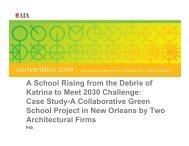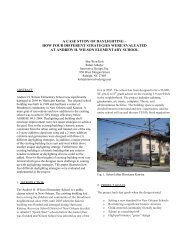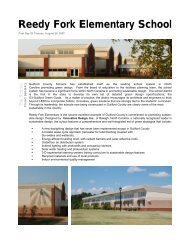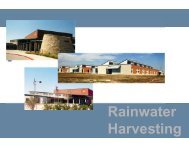SOLAR TODAY - May 2011 - Innovative Design
SOLAR TODAY - May 2011 - Innovative Design
SOLAR TODAY - May 2011 - Innovative Design
Create successful ePaper yourself
Turn your PDF publications into a flip-book with our unique Google optimized e-Paper software.
<strong>SOLAR</strong> <strong>TODAY</strong> ®<br />
<strong>May</strong> <strong>2011</strong><br />
VOL. 25, NO. 4<br />
Recognizing that non-hardware costs<br />
can add thousands to a system’s price, the<br />
Solar America Cities forge more efficient processes.<br />
By Hannah Muller<br />
At the onset, each of the Solar America Cities<br />
looked at issues specific to its local solar market.<br />
Cities like San Diego and Tucson, Ariz., were<br />
experiencing rapid solar growth due to favorable<br />
location and incentives, while others such as<br />
Portland, Ore., were working to overcome cheap<br />
electricity prices and public perceptions that solar<br />
is only for hot, sunny climates. Cities like Austin,<br />
Texas, and Sacramento, Calif., had had successful<br />
solar programs in place since the 1980s, operated<br />
by the municipal utilities, while New Orleans had<br />
an opportunity to incorporate solar technologies<br />
into buildings replaced or renovated after Hurricanes<br />
Katrina and Rita. Across all cities, however,<br />
some common hurdles surfaced. In particular,<br />
permitting and approvals plagued city planners<br />
and installers alike, adding time and unnecessary<br />
costs to solar installations.<br />
Easing the Permitting Barrier<br />
A key finding of the Solar America Cities program<br />
is that solar permitting, as it stands today,<br />
can be a significant barrier to greater solar energy<br />
adoption. According to a January report by solar<br />
company SunRun, local permitting, inspection<br />
and utility interconnection can add more than<br />
$2,500 to the cost of each residential installation.<br />
(Access the report at bit.ly/sunrunreport.)<br />
SunRun also found that local permitting is one of<br />
the most stubborn costs faced by solar installers<br />
nationwide, preventing some from being able to<br />
offer affordable prices to customers.<br />
Local jurisdictions typically require permits<br />
before a PV system can be installed, to ensure<br />
that the system meets safety standards. Following<br />
the installation, a city inspector will typically<br />
verify that the system complies with applicable<br />
codes. A system cannot be connected to the grid<br />
and operate until these steps are completed.<br />
Unfortunately, permitting processes and requirements<br />
vary greatly among jurisdictions, and local<br />
inexperience with PV has led to inconsistent<br />
enforcement of requirements. When you add<br />
understaffed city offices, it’s a recipe for permitting<br />
delays and burdensome costs, not only for<br />
Copyright © <strong>2011</strong> by the American Solar Energy Society Inc. All rights reserved.<br />
the installer, but also for the system owner and<br />
the local government issuing the permits.<br />
Various Solar America Cities have addressed<br />
this issue by developing processes that reduce<br />
time and cost for the parties involved, while<br />
maintaining public safety. Some cities are developing<br />
expedited processes and lowering fees for<br />
standard installations, while others have created<br />
a new way to submit the paperwork, either<br />
online or at a dedicated help desk, trimming<br />
hours or even days from wait times. Some cities<br />
are standardizing the process across neighboring<br />
jurisdictions, which provides the greatest cost<br />
savings for solar installers and can even enable<br />
cities to save money through innovative jobsharing<br />
arrangements where inspectors work<br />
across jurisdictions.<br />
Philadelphia is an example of a Solar America<br />
City that recognized early on that more-efficient<br />
permitting would improve local solar deployment<br />
rates. According to Kristin Sullivan, program director<br />
of the Philadelphia Solar City Partnership Program,<br />
“We’ve instituted multiple improvements<br />
to help the solar industry without compromising<br />
safety or requiring additional city staff time, including<br />
reduced permitting fees and a streamlined process<br />
for projects under 10 kilowatts.”<br />
San Jose, Calif.; New York City; and Portland,<br />
Ore., are three more Solar America Cities<br />
that have streamlined solar permitting.<br />
San Jose, Installers Collaborate. The city of<br />
San Jose has been promoting safe and compliant<br />
installation of renewable energy for more than<br />
nine years — and now serves as a model for<br />
other cities across the nation. According to Kathryn<br />
Sedwick, the city’s acting building official,<br />
“Much of the success of the permit streamlining<br />
is attributed to having the information available<br />
to applicants before they come in to obtain their<br />
permits and before they call for inspection.” One<br />
of the priority pieces of information available to<br />
installers is a checklist that provides all of the<br />
information needed to ensure speedy permitting<br />
and inspection. The checklist was crafted with<br />
input from the PV industry.<br />
➢<br />
Hannah Muller is the Solar America Communities<br />
lead at the U.S. Department of Energy. In this role<br />
she directs strategic investments in federal-local partnerships,<br />
cutting-edge pilot projects, policy analysis<br />
and nationwide outreach efforts to accelerate U.S.<br />
solar market growth through local action. Muller<br />
holds a master’s from the Bren School of Environmental<br />
Science and Management at the University of<br />
California, Santa Barbara.<br />
Resources: Simplifying<br />
Solar in Your Community<br />
I<br />
n January the U.S. Department of Energy<br />
(DOE) released “Solar Powering Your Community:<br />
A Guide for Local Governments,” a<br />
comprehensive resource. The new edition<br />
contains recent lessons and successes from<br />
the 25 Solar America Cities and other communities<br />
promoting solar energy. Download<br />
a copy at solaramericacommunities.energy.<br />
gov/resources/guide_for_local_governments.<br />
Recognizing the need for standardization<br />
in the solar industry, the DOE also has created<br />
a clearinghouse for information on solar<br />
codes and best practices. Its Solar America<br />
Board for Codes and Standards, established<br />
in 2007, published a model expedited-permitting<br />
process in 2009. The state of Oregon<br />
used it to help create its standardized state<br />
permitting codes. For more information visit<br />
solarabcs.org.<br />
Find more information on the 25 Solar<br />
America Cities at solaramericacommunities.<br />
energy.gov.<br />
solartoday.org <strong>SOLAR</strong> <strong>TODAY</strong> <strong>May</strong> <strong>2011</strong> 43









